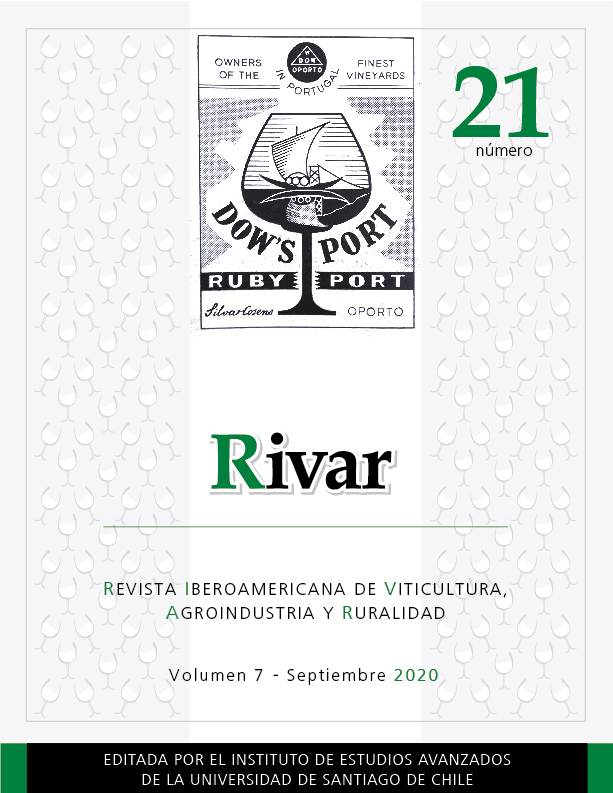The Brand as Value Production. From the Trademark to the Designation of Origin of Wines from the Douro Demarcated Region
DOI:
https://doi.org/10.35588/rivar.v7i21.4642Palavras-chave:
vino de Oporto, marca comercial, Denominación de Origen, Región Demarcada del DueroResumo
At the end of the 19th century, modern commercial brands emerged after the creation of the legal framework for their protection and the birth of large commercial companies. In the Portuguese wine sector, there was a strong adhesion of companies to the registration of trademarks as a defense against practices of “abusive use of false or misleading indications of provenance”, in a context of post-phylloxera reconversion, market instability and the proliferation of imitations and counterfeits. The commercial sector took ownership of the brand in its identification with the designation of origin, leading to the emergence at the beginning of the 20th century of a movement led by prominent personalities from the Douro Region in the sense of creation of legal mechanisms to defend the regional brand of Portwine. We will analyze three historical quintas (estates) — Senhora da Ribeira, Bomfim and Zimbro — and the marks (brands, labels and fire marks) of Silva & Cosens, the “most respectable” company in the Douro wine trade in the early 20th century. We aim to undesrtand how this company created trademarks with a strongly identifying character with the Douro Demarcated Region, the producing region of its wines.
Downloads
Referências
Aguiar, A. and Lopes, T.S. (2000). “A marca e a internacionalização do vinho do Porto”. Douro – Estudos & Documentos 5(9): 121-143.
Almeida, A.R. de. (1999). “Denominação de origem e marca”. Studia Juridica – Boletim da Faculdade de Direito da Universidade de Coimbra 39: 141-175.
Borges, I.C.C. (2014). “A personalização da rotulagem do vinho Virgo: um casus na contemporaneidade”. Douro – Vinho, História & Património 3: 131-142.
Dias, J. (2019). “A situação actual do sector do vinho do Porto no plano empresarial”. In Guichard, F., Roudié, P. and Pereira, G.M. (coords.). História do Douro e do vinho do Porto. O vinho do Porto e o Douro no século XX e início do século XXI. Vol. V. Porto, Afrontamento: 143-159.
Guichard, F. (1997). “O vinho do Porto e mais alguns: gestão da imagem”. Douro – Estudos & Documentos 1(3): 145†‘157.
Mayson, R. (1999). Port and the Douro. London, Faber and Faber.
____. (1998). The story of Dow’s Port, 1798-1998. S. l. London, Segrave Foulkes Publishers.
Monteiro, M. (1998). O Douro: principaes quintas, navegação, culturas, paisagens e costumes. Fac-simile da edição de 1911. Porto, Livro Branco.
Moreira, V. (1998). O Governo de Baco: a organização institucional do vinho do Porto. Porto, Afrontamento.
Pereira, G.M. (2010a). “A evolução das práticas vitícolas e de vinificação”. In Pereira, G.M. (coord.). (2010). História do Douro e do Vinho do Porto. Crise e reconstrução. O Douro e o vinho do Porto no século XIX. Vol. IV. Porto, Afrontamento: 142-215.
____. (2010b). “A evolução do espaço regional. Das demarcações pombalinas ao Douro pós-filoxérico”. In Pereira, G.M. (coord.). (2010). História do Douro e do Vinho do Porto. Crise e reconstrução. O Douro e o vinho do Porto no século XIX. Vol. IV. Porto, Afrontamento: 10-49.
____. (1996). “A região do vinho do Porto – origem e evolução de uma demarcação pioneira”. Douro – Estudos & Documentos 1(1): 177-194.
____. (1991). O Douro e o vinho do Porto. De Pombal a João Franco. Porto, Afrontamento.
Pereira, G.M. and Almeida, J.N. (1999). Porto Vintage. Porto, Instituto do Vinho do Porto and Campo das Letras.
Pereira, G.M. and Cruz, M. (2017). “Origem e distinção: as marcas de vinhos no final do séc. XIX”. CEM/Cultura Espaço & Memória 8: 409-425.
Pereira, M.B. (1947). No País do vinho do Porto. Porto, Instituto do Vinho do Porto.
Sequeira, C. (2011). O Alto Douro entre o livre-cambismo e o proteccionismo: a “questão duriense” na economia nacional. Porto, CITCEM and Afrontamento.









